This is not a review. That’s coming after further use and reliability testing. But Chris and I were so impressed with Ultradyne‘s new flip-up iron sights that I wanted to show them to y’all right away . . .
Spoiler alert: the front post is an aperture sight. That’s right, Ultradyne’s C4 Folding Sights are a dual-aperture setup. It isn’t the first — this is how biathlon sights are generally designed — but it may be the first for the AR-15 market.
Different front aperture diameters are available. Standard in the C4s is a 12 MOA aperture, which is seen above second from the right.
The rear aperture is also exchangeable for other sizes. It’s very simple to unscrew the aperture insert from the sight.
Leaving the rear aperture out completely turns the rear sight into a ghost ring for extremely quick acquisition.
On the left side of the rear sight is an elevation dial that’s click-adjustable for distance. Chris and I found it to be spot-on out to the 440-yard back wall of the range we used for testing (where we abused steel plates from 200 to 440 like you wouldn’t believe), and will test it even farther for the full review.
That dial is aligned for the ballistics of M193 ammo, but the end user can calculate a drop table for other loads as well (e.g. “4” on the dial might be a 375-yard hold for 75 grain ammo instead of its normal 400-yard hold for 55 grain).
Don’t worry about losing that rear aperture, either. Simply screw it into the elevation adjustment dial for storage.
Ultradyne’s C4 front sight is also adjustable for elevation, as you’d expect, but it’s adjustable for windage, too. I can’t recall seeing that before. While not strictly necessary, it provides one really cool benefit: the rear sight stays centered in its housing.
Ultradyne recommends you sight in your gun via front sight adjustment, not rear. That way you’re sighted in with the rear sight centered so you can actually adjust the rear for windage while shooting, then easily return back to its center zero.
That’s not even the coolest adjustment feature of the front sight, either. Instead of requiring a tool to release the detent and rotate the front post, the user simply clicks the front sight hood down, then rotates the post by hand. Since the aperture is drilled through, front-to-back as well as side-to-side, front can become side and you still have an aperture to look through (you have the normal 90° rotation steps).
Better yet, the front post always remains centered in the hood. This is huge for your eyes and brain, which just love centering circles in circles.
In fact, this is why the whole setup is so freaking fast and accurate. Centering that round front aperture in the round rear aperture with the help of the round front hood aligning inside the rear is incredibly precise — which I think is easy to imagine — but also orders of magnitude faster than Chris or I expected.
It’s beyond easy; it’s instinctual. Trying to center a square front post in a round rear peep sucks. It actually makes no visual sense (in fact, I’ve historically run KNS ball front posts on my rifles). The Ultradyne system clicks instantly. It’s easy and oh-so-fast to teach, learn, and use.
An aperture front post also allows you to see the target. Don’t focus on the front sight, and don’t deal with the front post obscuring your target, either. Center the target in the front aperture, focus on the target, and squeeze the trigger. Viewing through apertures actually provides a certain amount of vision and parallax correction, too.
But wait! There’s more! While Ultradyne’s standard C4 Folding Front Sight mounts on your top rail, their C4 Dynamount front sight mounts on the barrel itself. A pin on the sight indexes into one of three holes on one of Ultradyne’s muzzle devices (centered, or 45° offset to either side), and a lock nut clamps it all together, making timing easy.
I know, it may seem like a gimmick. That’s where my head was when I initially saw this setup. But when you take even the highest quality, free-floating rails, put just a pound or two of pressure on them, and watch your rail-mounted front sight walk off target, you understand the choice.
We’ll have some of this rail flex-induced point of aim shift data in the full review (10 MOA of shift is shockingly easy to induce).
With the rear sight mounted solidly on the receiver and the front sight on the barrel, that concern disappears. Sight radius, too, is stretched to as long as possible for the most precise alignment for your rifle. It may look a little goofy — or at least non-traditional — but dangit, it works. And timing that front sight was far easier than expected.
The Dynamount front sight still folds, and will sit right down on top of a full-length upper rail should your handguard extend that far.
Machining and finish on these Ultradyne parts is as good as we’ve seen in any product. The wide, notch-style detent used to snap the sight into deployed position is as snug and solid as can be.
Basically, these are probably the best iron sights on the market. And I won’t even call them “backup irons,” because they’re so freaking fast and so accurate that they’re better than many optics. These sights are going to find themselves on my first dedicated iron-sights-only AR-15 build.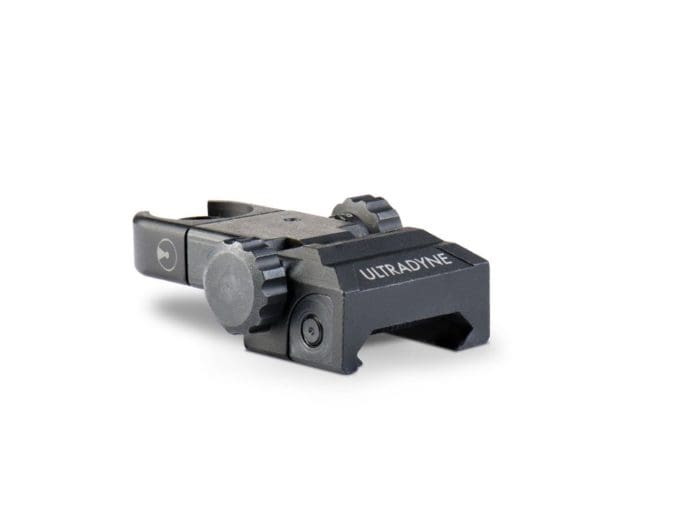 Downside? They ain’t cheap. A C4 front/rear combo runs $274. Go with a C4 rear, C4 Dynamount front, and a compatible muzzle device and you’re into it for about $350. That’s MSRP; they’re a bit less via Brownells. But polymer backups on the cheap, they are not.
Downside? They ain’t cheap. A C4 front/rear combo runs $274. Go with a C4 rear, C4 Dynamount front, and a compatible muzzle device and you’re into it for about $350. That’s MSRP; they’re a bit less via Brownells. But polymer backups on the cheap, they are not.
Stay tuned; full review pending.

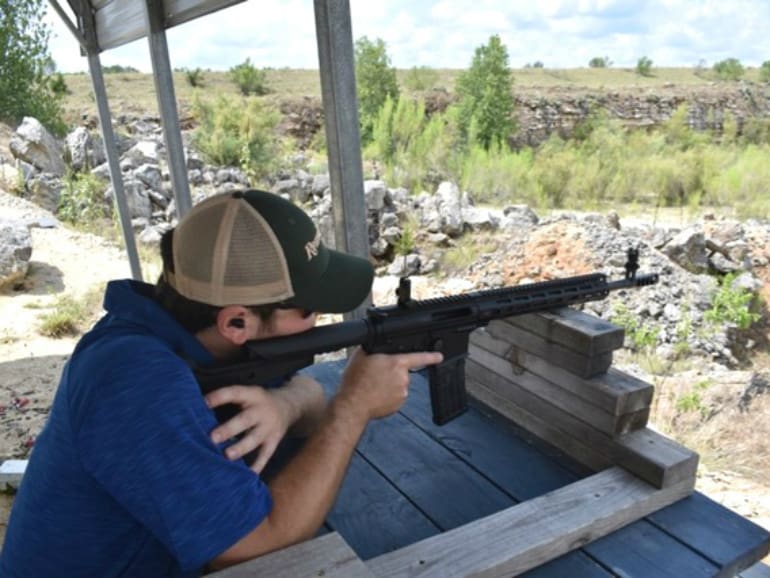
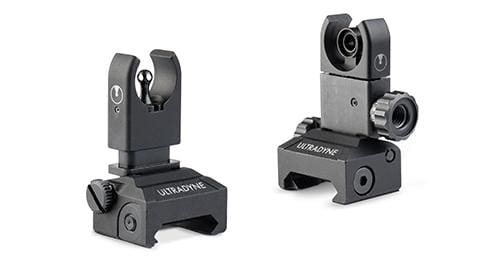
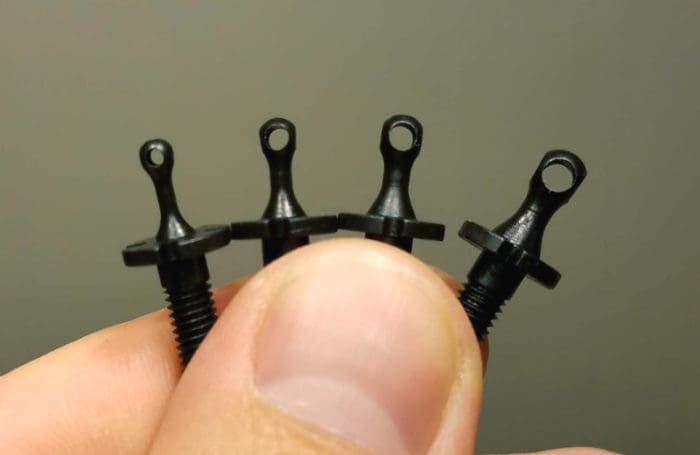
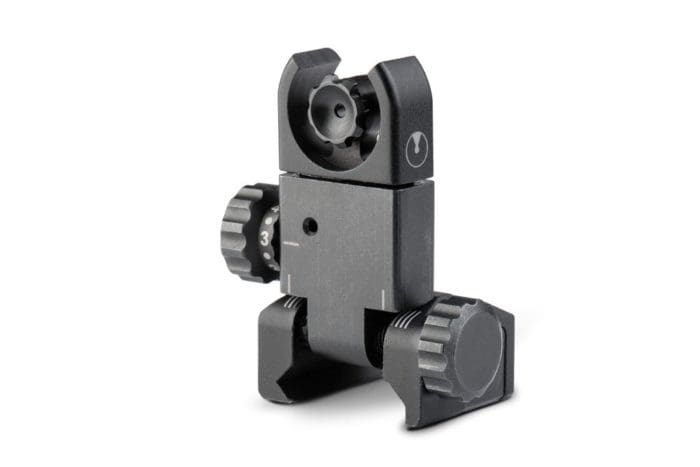
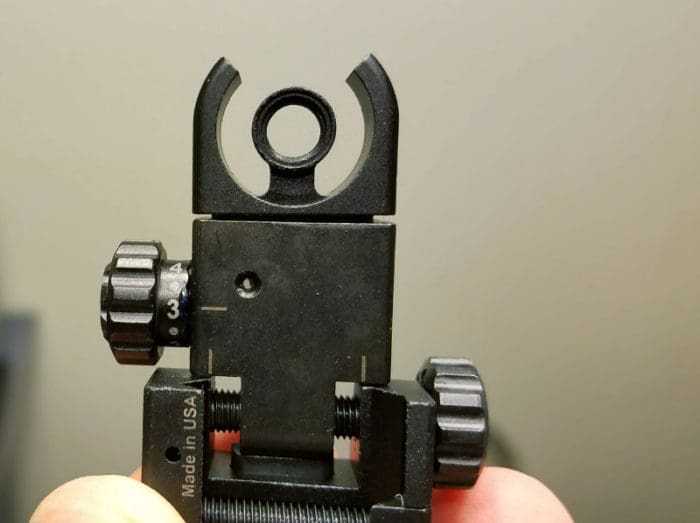
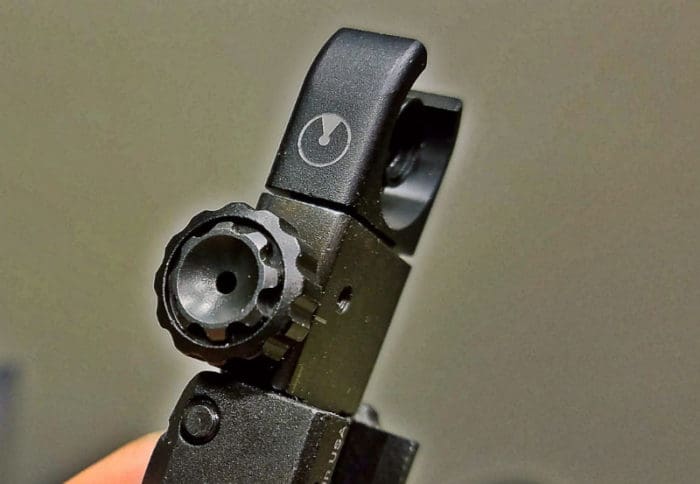

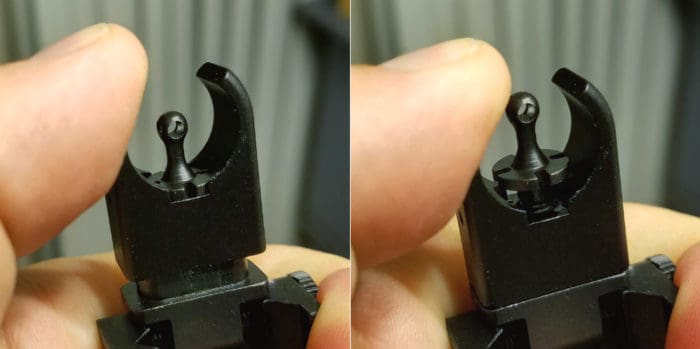
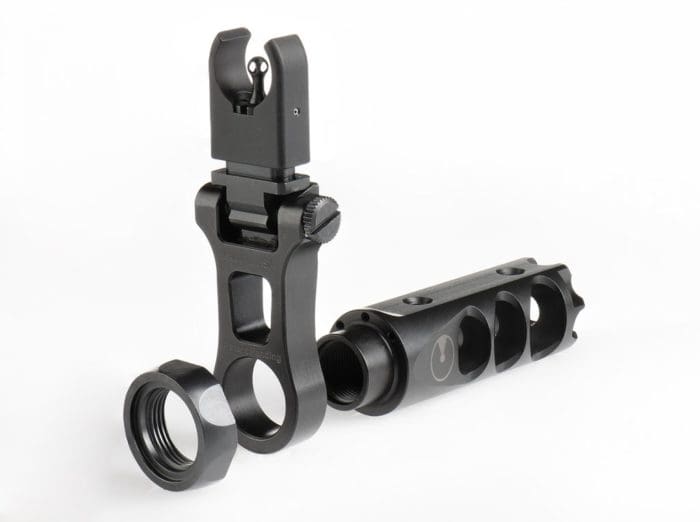
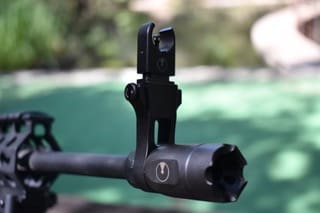


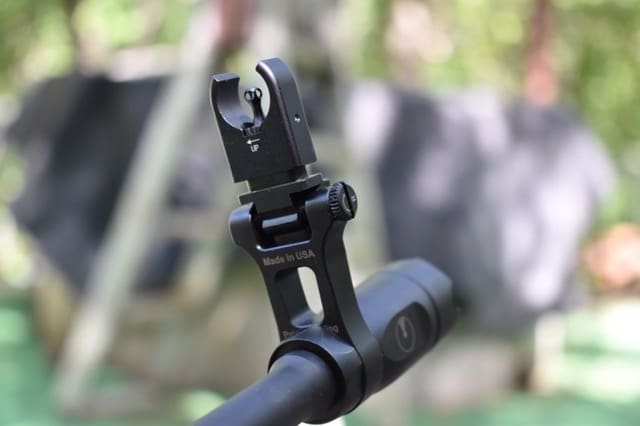
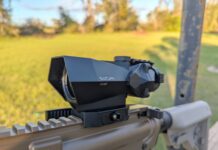


Awesome. Please test in low light conditions, like dawn and dusk, where front aperture sights tend to fail.
Exactly, jwtaylor! Additionally, at that price will they become sentient and try to take over the world? Oh, wait. That’s Cyberdyne not Ultradyne. I get those dynes mixed up sometimes! 😉
Outstanding non-review!
I’d be happy to formally review the sights for TTAG if you send them to me.
Oh and is copy control-C? Thanks.
No worries. I get dikes and dykes mixed up too.
Yes they are set to become self-aware on July 12, 2020 at 12:16
Even if you can’t see through the front aperture, you’re now left with a front ball sight much like the KNS ones I’ve come to like. Center the ball on the target and you’re there. Not as precise as being able to see the center of the target inside of the aperture, but approximately the same as any other sight on the market where you have to obscure the target with the post anyway.
If you sight these in by looking through the front aperture like you are supposed to, you can’t really transition to using the top of the front aperture as a round post. Your elevation will be off quite a bit. By 1/2 the MOA of the front aperture + the thickness of the aperature. So if you have the 10 MOA front aperature you will be over 5 MOA low.
If you are only going to shoot round paper targets or plates, these will work great. If you are going to use them for anything else, they will suck. There is a reason that you usually only see globe front sights on target rifles used for shooting round targets. Even back before scopes were common and very high quality rear peep sights were available from Lyman and other companies, they almost universally used a front post.
Cletus,
Here is a guy who says just the opposite. He says irons are better close and for moving targets. He went so far as to invent offset irons.
https://www.youtube.com/watch?v=NCmItUbFZCE
My experience with aperture front sights is that they are also very good for “general” field targets. For rifles that will accept them, I use a Lyman 17A of appropriate height along with an insert that looks like a circle suspended by a cross hair from Lee Shaver Gunsmithing. If the target is small enough to fit in the circle, e.g. a squirrel’s head, you focus on that. If the target is much larger than the circle, e.g. a deer’s chest, then you use the circle as a dot. With my older eyes, even with an aperture rear the front circle is often “fuzzy”, but it doesn’t matter. If you can see the target through the front aperture, you eye is looking at the target that does not appear blurred, and you are good to go. If the target is large, you can aim fine with the “fuzzy dot.” All iron sights are challenged in low light compared to an optic, but aperture front sights are not just for the target range.
This is the situation where your rail mounted light comes in to play.
” Please test in low light conditions, like dawn and dusk, where front aperture sights tend to fail.”
That’s when my 50+ year-old eyes start to fail, dusk. It downright sucks not being 25 anymore…
*sobbing pitifully*
Looks like a solution looking for a problem.
Yeah, a firing solution.
No problem.
I like the sights but not really keen on having to swap out my muzzle device.
There are so many muzzle devices and people will opt for some over others, and some are required for silencer compatibility, or use with flash can/forward gas redirectors, etc, so I don’t really want to use ultradyne’s brake even if it has all the neato specs, it has to work with Rugged suppressors for me.
I dunno, I like the style of the long rail, minimal barrel with rail mounted sights, but now that they are ubiquitous I guess the kewl kids are either going Brownells retro or back to barrel mounted sights.
Some of the new HK 416 variants have barrel mounted flip up sights as well, so maybe that will be the next tend. “Ditch that mlok rail! You call yourself an operator?”
Y’all did see that there’s a rail-mounted front sight, too, right?
Some of us are not set up with front rails*, and this would be perfect. But $350 is quite a bite if you already have a muzzle device you are happy with (and probably paid a pretty penny for). What happens if you just mount it without one of their muzzle devices?
* My rifle is set up with a round tube front end (Hogue) that free floats the barrel, but requires sights like these or a scope/red dot with no back up because there is no place to mount a front sight. Which is fine for its intended purpose. Funny thing is, the longer I own this rifle, the more it costs me, even though I don’t shoot it very much!
Interesting, but given cost vs benefits of this system, I’ll stick with my MBUS with KNS hooded reticle.
So, uh, what if you live in a Commie state like New York and have a crowned barrel?
That’s why they still make the rail-mounted front. Not everyone wants to or can do the barrel mount option.
Should have waited for the full review…or my reading comprehension sucks…
Reading comprehension AND visual acuity. Just sayin’ 🙂
Move out of NY State. but before leaving, give them straws (if those are still legal) and spit wads.
Very cool sights and idea; however, they are about 30 years too late… I will stick with my holographic sights for my primary… and these are just far too expensive to justify for BUIS.
nice design, WWWAAAAAYYYY over priced. we sure these aren’t made by Kimber?
I was all excited until I saw the price. For that much money, I can purchase a nice optic.
Once the .308 Apollo brake comes out for me, at least, the cost is easily a secondary consideration.
I’m glad I checked out those KNS ball-post front sights. Looks like they’ll drop right into Magpul BUIS, which for me right now are not backup, but the *only* sights I’ve got on my AR.
Noice! Definitely getting some.
These Ultradyne dinguses would be nifty, but they’re waaaaay too expensive for my budget. At that price, I could (eventually probably will) buy a Primary Arms 1-4x optic that would actively correct my crappy vision.
Ing,
I came to the exact same conclusion above: these sights are too expensive for what they are and will simply drive me to purchase a 1-4x optic as well.
Some of us even “older” folks have had to upgrade from 1-4 or 4x fixed to 3-9 because of decreasing visual acuity. I’ve been shopping for a more powerful optic for my .22 because seeing things at 100 yards is getting tougher all the time.
These will make yer nose bleed. They’re nice though, have a set on one of my K31s.
https://www.grafs.com/catalog/product/productId/17802
” Standard in the C4s is a 12mm aperture, which is seen above second from the right.”
Something wrong here, 12mm is roughly 0.5″ or are those giant thumbs?
Crap, thanks. Should have said 12 MOA, not mm! …fixing…
Easy mistake. No problem. Fix is in.
Since I’m sure folks will ask, yes, “12 MOA” aperture does depend on how far the sight is from your eye. That information and more is on the Ultradyne website and apparently they’re going to do an app or online calculator or something if you want to get really deep into the weeds on it. The ideal scenario (apparently) is that your target fits inside of the aperture with 3 MOA of space around it (all within the aperture). So if you have a 4 MOA target you’d want a 10 MOA sight aperture (3 MOA of space on both sides = 6 MOA of additional size on top of your 4 MOA target). Anyway, ultimately it’s a rule of thumb sort of a deal and it’s a balance between ultimate precision and fastest acquisition. Chris and I found these to be both more accurate than traditional irons and way faster.
So… you like it?
Can we see how it looks with windage adjusted on the front sight? Would it still be centered?
Yes, it moves the entire hood and everything above the screw/bolt that does the actual windage adjustment. So the post stays dead center in the hood because that entire assembly moves left/right.
Very interesting to me. I’ve used front and rear aperture sights on a Swedish Mauser for some years and am a big believer. Even pondering going that route on a K31, but the prices I’ve found for those are up to double the price of the sights in this article, so no action yet on those. Never occurred to me that I could achieve this on an AR-15.
Sometimes old school is just awesome. Not necessarily better, but awesome nonetheless.
This is good material, bookmarking and saving as a screen grab for later reference. More stuff like this plz.
I am just so pleased that companies are continuing to evolve and develop iron sights systems. I still default to my “backup” iron sights for 90% of shooting, regardless the platform. In a world where rifles are frequently shipped now without even bothering to include the most rudimentary sights (because, “why bother– you’re just going to put a red dot or scope on it….”), it warms my heart that companies understand physical sighting systems not only have a place of relevance for shooters, but are preferred in many situations.
I realize the value and necessity of optics. It was only a couple years ago when I found myself past dusk camped at a creek crossing, with multiple bears in the area, stuck out in pitch black with a rifle that I could not aim because I could hardly see the irons, much less pick them up on target. I had bought a brand-new Eotech 512 (for $150!) from a pal who bought it new and couldn’t “figure it out” …and I popped out a laser boresighter from the stock storage, took the HWS out of the box and dialed in the reticle in pitch black night in the woods. In the mountain woods, my epiphany that night was, “Put the red dot on the growling shape” does beat trying to acquire irons at night. (Yes… headlamp. We’re not shooting into total blackness, of course….) At dawn I realized the Eotech was perfectly co-witnessed with my irons, so I have left it on ever since… turned on when necessary. This good experience led me to similarly set up other rifles, and eventually get a 3x scope with a drop compensator and range estimator (the PA ACSS system…).
But until that “a ha” reminder moment comes of why optics are great and really save the day, it’s mostly irons for me. (I will admit, I used to even poo-poo optics as sort of gimmicky, while saying “Hey, if it works for you, more power….”) We tend to stick with what we were taught, what we know, and what works to get the pill on point… but I am very excited to see some innovation in improving upon the known-quantity and reliability of iron sights. And I just might have to check these guys out. As for price, “cry once, smile often” I guess.
Thanks, Jeremy for always trying to bring us cool and new things to enhance shooting. Be safe.
These look fantastic! I like the idea of having solid irons to rely on over any kind of fancy gadget for aiming. I actually just purchased my first rifle, and using Magpul’s MBUS flip sights was relatively painless, but as you said, I found it awkward trying to center a square post in a circle aperture. This seems much more practical and intuitive.
Now if they’d just make them with a spring-assisted flip up variety friendly for use with .308 and I’m on board.
Well, then, get on board.
Feel free to send an e-mail to a Gentleman (Mr. Marshall Foster) at Ultradyne with whom I’m been corresponding about the .308 Apollo brake they’ve said they’d soon be selling (at [email protected], or even better, [email protected]).
Here’s the text of his most recent e-mail exchange with me:
“Good Morning David,
My apologies for the delay in response, but we did actually just talk about the .308 Apollo this morning and it should be ready very soon!
I will be sure to keep you in the loop.
Marshall Foster
Ultradyne USA
Sales Team:
The problem with the spring assist is that they don’t always bounce to the same spot. Take any sping-assisted bouncy sight and just give the sight a little touch. They wiggle. Those are BACK-UP, oh-crap, point in that general direction sights. These seem to be made for a completely different reason as precision sights.
Blitzkrieg Chevron front post for MBUS is also intuitive, a lot cheaper and works well in low light.
Windage. That’s something you don’t see discussed everyday with Iron Sites. Back in the day while shooting M14’s at the Camp Pendleton Range at 1,000 yards, windage was hard to adjust for much less to keep. Reading this abbreviated Review it would be nothing short of a miracle to overcome and gain help when shooting at those long range distances.
Looking forward to more info about this Site.
Semper Fi!
They should make an option for the rear sight to have 1/4MOA adjustments instead of the calibrated to M193.
Nice, sure. But not essential.
Anyone with a bit of math and knowledge of using an Excel spreadsheet can easily develop a dope card that identifies the range that each click represents; after measuring the MV of your favored load in your particular rifle, knowing the ammunition BC, performing the box test at 100 yards on the load / rifle and using a ballistic calculator to determine the drop at, say, 10 yard increments (or any increment you like).
I have a PSA AR-10 build in process and chanced upon a write-up on these sights and am delaying finishing it because Ultradyne’s AR-10 Apollo brake in 7.62 isn’t quite on the market, yet (I’m assured by their sales dept. that it’s coming quite soon).
I agree with the author, this is a near-revolutionary BUIS. And, the author mentions a number of important things that make it so. But he left out one pretty important feature.
The manner in which the front sight elevation works does not change the sight picture regardless of how elevated or depressed the front sight is…the aperture stays right in the middle of the circle formed by the side blades regardless of elevation applied. So, the concentricity of the whole sighting system is maintained no matter how much elevation you apply to the front sight.
KAC’s sights used to be cat’s meow both for civilian and military AR-based rifles. I own some on my rifles.
But this sighting system appears to have substantial advantages over the KAC systems and it should be given a hard look by the services.
Actually I did not leave that out, but mentioned it specifically. Find that under the photo showing how one adjusts the front sight for elevation.
You’re right Jeremy.
I read your article again and thought I wish I could retract my post.
Sorry, sincerely. Thanks for the article.
Best
I spent about an hour or two on the phone with the owner of ultradyne.
I think that the problem of centering the front sight is largely a non issue due to the parralax suppression of the peep sight.
We think we need to center it, and it becomes another operation in the sight picture… I.e. we must align the sight within the circle, then align the sight with the target.
This is largely unecessary.
“Now, if we move our eye from side to side a little bit, our first thought
is that the point of perspective would change. But since the point of
perspective is at the center of the sight aperture, and that is fixed, the
point of perspective does not move.
And this is why there is essentially no manifestation of parallax shift
with modest amounts of eye movement in an aperture sight.” – “Parallax Suppression with a Target Rifle Aperture Sight”
Robert J. Burdge and Douglas A. Kerr, P.E.
So while the ring in a ring may be intuitive for the eye to naturally center the front sight, it remains largely unecessary as parralax is suppressed anyway when using a small enough peep.
These sound like they would be very nice, but as others have pointed out, the price is a bit on the high side.
It seems that their target market consists of three demographic groups:
1. Firearms industry writers who get free stuff to review
2. “Elite” government agencies funded by OPM (Other People’s Money)
and
3. $ERIOU$ $HOOTER$
This sight looks interesting to say the least. If I understood the pictures correctly, the REAR sight is adjustable both laterally and vertically, that is to say for windage and elevation, which is as it should be. By the way, regarding apature front sights, when I shot bolt action rifles in High Power Rifle competition, I used Redfield Olympic Sights, that included plastic apature inserts for the front sight. They worked very well indeed.
and elevation
Cletus, perhaps you should stick to commenting on things you understand (if there are any). Get someone who has ever seen a KNS Ball sight to explain to you how it works. That way you will make LESS of a fool of yourself.
HAHAHAHAHAHEHEHE!
The above comment/questions are quite interesting, but I wonder as to the following. The old Garand, which I shot in competition for 5 plus years I thought excellent Iron Sights. Ditto for the M-14/M1A, Front post, rear sight adjustable for both windage and elevation. Eventually, I wore out my old Garand, and went to bolt guns, Model 70’s mostly, using Redfield Olympic Sights, the rear sight adjustable for windage and elevation, as they should be. That nobody, correct me if I’m wrong, has come up with a similar reasonably priced sight arrangement for AR-15 type rifles strikes me as curious, or have I missed something along the way?
The sights on the M16a2 are just as good as the M1 Garand and M14.
The A2 sights on M16-A2 and M4 rifles have a rear sights adjustable for windage and elevation, along with a front sight adjustable for elevation only. Unlike the earlier M16 and M16A1, the front sight is only moved during the initial zeroing of the rifle or if shooting matches at 1,000 yards because the rear sight runs out of adjustment. The front sight bases are also usually held on with set screws on National Match rifles so you can sight in the rifle with the rear sight perfectly centered.
National Match AR15 rifles also use pinned rear sights so the sight tracks correctly. One or two hardened steel pins are inserted into holes drilled through the aperture assembly into the sight base. You can get either 1/4 or 1/2 minute click adjustments and different sized hooded apertures that are swappable. Both fixed carry handles integral to the receiver or removable carry handles are available, with removable being preferred because you can just move the sight to a different upper when the time comes to replace it.
网课代修 049
Comments are closed.